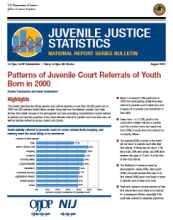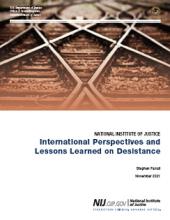Habitual offenders
Criminal Careers and 'Career Criminals' - Conference Proceedings
Selecting 'Career Criminals' for Priority Prosecution
Repeat Offenders - Crime File Series Study Guide
Duration of Adult Criminal Careers - Final Report
Classification, Prediction, and Criminal Justice Policy
THEORETICAL PERSPECTIVES ON ALIENATION IN THE PRISON SOCIETY - AN EMPIRICAL TEST
Offender Interviews: Implications for Intelligence-Led Policing
A Longitudinal Assessment of Head Injuries as a Source of Acquired Neuropsychological Deficits and the Implications for Criminal Persistence
Remarks By James K Stewart to the New England Council on Crime and Delinquency Prevention, Narragansett, Rhode Island, September 25, 1985
Research Program Plan, Fiscal Year 1988
Remarks of James K Stewart Concerning The National Institute of Justice
The Cycle of Violence: Abused and Neglected Girls to Adult Female Offenders
Crime and Justice: A Review of Research, Volume 30
Employment Services for Ex-Offenders Field Test - Detailed Research Results
Just Science Podcast: Just Trauma-Informed Approaches and Advocacy for Vulnerable Populations
Desistance: It's a Process, Not an Event
Patterns of Juvenile Court Referrals of Youth Born in 2000
Integrated Treatment for Jail Recidivists With Co-occurring Psychiatric and Substance Use Disorders
Booker and Beyond Analyzing Sentencing Reform and Exploring New Research Directions
This webinar features a discussion of previously published research on the U.S. Supreme Court’s 2005 Booker decision - which effectively transformed the United States Sentencing Guidelines from a mandatory, to an advisory, system. The presentation will address selected research findings from the last 15 years. Individual participants will briefly review their previous research findings with particular attention paid to the analytic methods used.
See the YouTube Terms of Service and Google Privacy Policy
Desistance From Crime: Implications for Research, Policy, and Practice
Most scholars would agree that desistance from crime – the process of ceasing engagement in criminal activities – is normative. However, there is variability in the literature regarding the definition and measurement of desistance, the signals of desistance, the age at which desistance begins, and the underlying mechanisms that lead to desistance. Even with considerable advances in the theoretical understanding of desistance from crime, there remain critical gaps between research and the application of that research to practice.
See the YouTube Terms of Service and Google Privacy Policy








